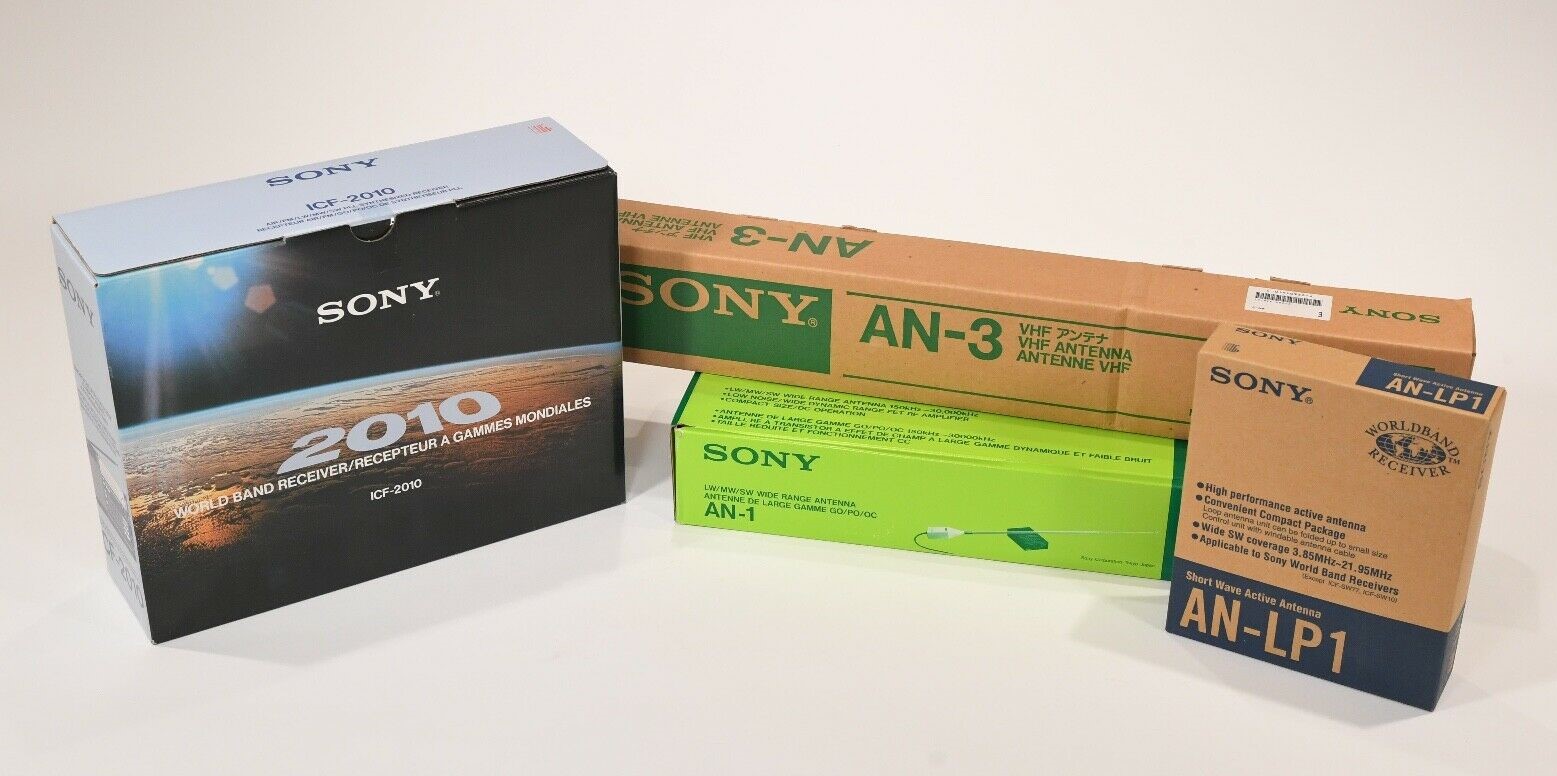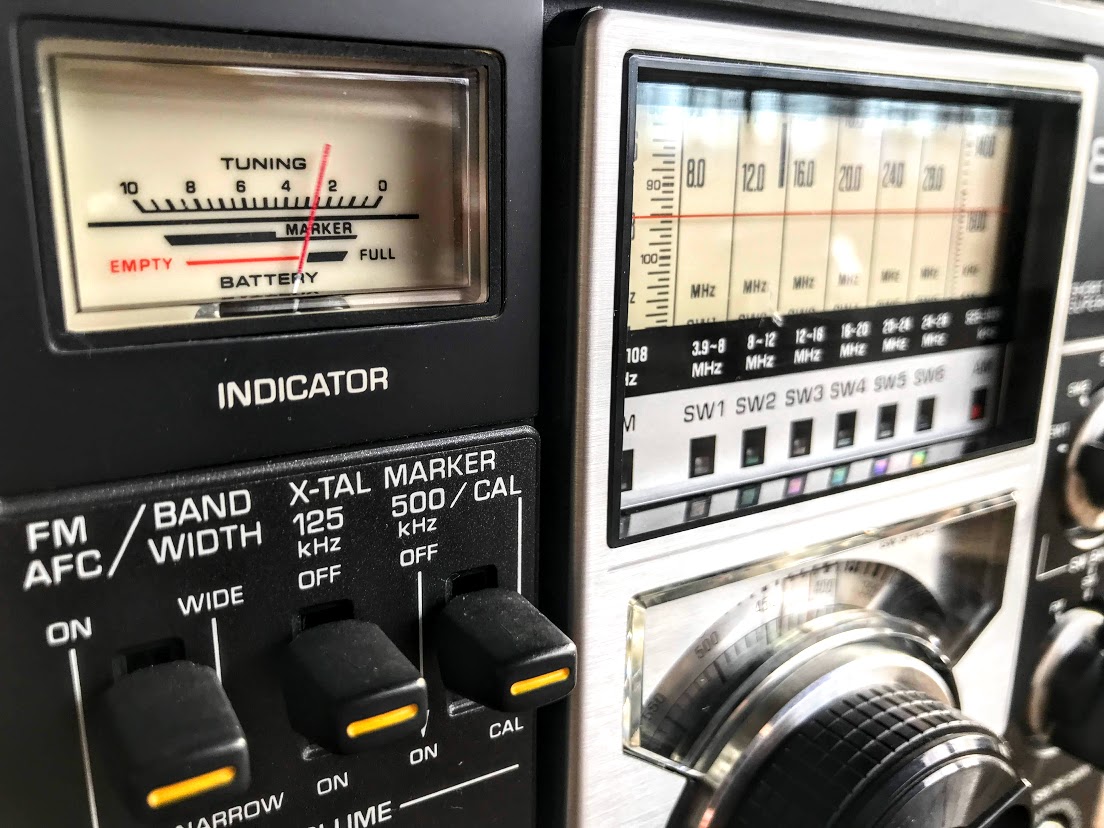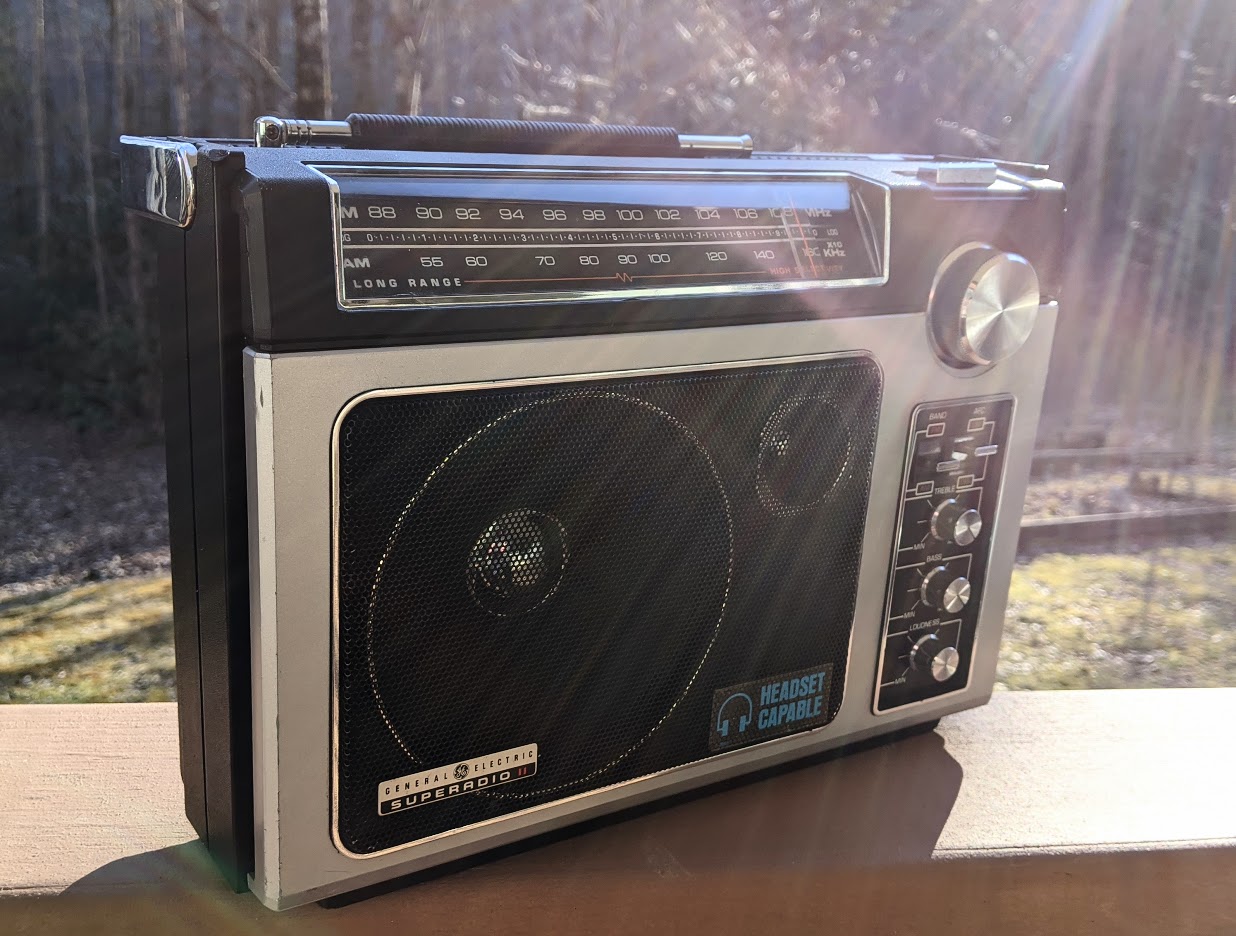After posting links to a few used radios online yesterday, SWLing Post contributor, Jim Teddford, commented:
The thing to remember when buying solid state mulitiband radios online is that you’re buying “a pig in a poke.” Meaning you are buying a radio at your own risk. Radios from the 70s/80s/90s-(Panasonic Command Series and the Sony classics: ICF-6800, ICF-2021, etc.) are now to the point where components like capacitors, displays, knob/switches etc.are failing due to age. Unless you can repair or restore the radio, don’t buy it. Just admire the photo online.
Jim has a valid point here and it’s one I echo a lot when readers contact me asking if they should, for example, be looking for a used Sony ICF-2010 instead of a new radio like the Tecsun H-501x.
Although I bet 1970s-1990s era solid-state radios have much better longevity than our newer DSP receivers, at this point you must assume components will need to be replaced.
I’ve purchased two Panasonic RF-2200s in the past decade and both needed to have capacitors replaced, an internal cleaning, and DeOxit applied to the switches and pots. I assumed this much when I made the purchases. Mechanically, the radio worked well, but…what…four decades(!?!) of age will take a toll on the internals.
I’m not an expert on re-capping and restoring vintage radios, for that I rely on folks like Vlado and Chuck. Mentally, I set aside a budget to have work done on the radio and I add that to the purchase price.
Most of the time, components like capacitors, resistors, inductors, etc. can be replaced with no issues.
Keep in mind, though, that some items particular to any one model–like digital displays and integrated circuits–may already be obsolete. I’ll be the first to admit that if a digital display doesn’t work on a used solid state radio, I skip it for this very reason.
So when a newcomer to the radio world asks me they should purchase a used Sony ICF-2010 or a modern portable that’s still in production, my tendency is to dissuade them from the vintage set unless they have the skill or funds to give it a little TLC if needed.
With those disclaimers out of the way, I must say that I’ve yet to meet a modern DSP radio that has the audio fidelity of a 1970/80s era solid state radio like the GE Superadio or Panasonic RF-2200. And the Sony ICF-2010 or the Panasonic RF-B65? Both are still benchmark receivers and can wipe the floor with many of our late model radios.
In a nutshell: if you’re willing to put a little time and money into re-capping, repairing and restoring a reputable solid state radio, go for it! Otherwise, stick with a late model receiver that may even be backed by a manufacturer’s warranty.
Me? I’m willing to take the risk and invest to give these vintage portables a new lease on life!
SWLing Post readers: What do you think? Have you ever purchased a solid state radio that failed shortly after purchase? Have you ever restored a solid state radio? Did I miss any important points? Please comment!




If you have a radio that needs repair, it can often be something simple. This is especially true of transistor sets. Here’s source of advice: childhoodradio.com/quick-fixes/
All very true, and good advice. But do consider that the skills required to do routine restorations — replace electrolytics, fix dirty contacts, clean and polish cases etc. can be easily learned. Many folks find the process fun and educational.
Just get some knowledge online and start by working on simple sets that don’t have any sentimental value to you. See how you like it.
https://childhoodradio.com/make-it-play/
https://childhoodradio.com/restore-appearance/
I agree with 13dka’s comments above. If you have the repair skills and tools/test equipment to support that, buying used solid-state radios from the 60s/70s/80s will probably work out for you. Otherwise, it’s a risk. Sometimes you get a radio that just needs knob/switch contacts cleaned, sometimes you get one where more extensive repairs are required.
If you have the requisite skills and resources, repairing solid state radios can be part of your radio hobby, and when you manage to repair a radio, it’s a great feeling. But if you want to buy a solid state radio and hope it works perfectly with minimal effort, you’re likely to be disappointed.
My favorite era is the mid to late 1960’s. The schematics are easy to find and have lots of information. One point of caution is you really have to strip it all the way down and clean.. clean.. clean.. They use this “no clean flux” that causes problems.( I think radios were designed to die with age) Take good color photographs and label wires. I have taken boards and gave them a both in alcohol/acetone followed by a ammonia and 409 spray cleaner with thorough water rinsing. followed by an “oven drying” at 150F and reassembling. be especially careful about IF cans and tuning condensers. this can be a real problem with the solvents. I had dead radios that actually started working again but needed realigning.
…thanks for this excellent information on purchasing mature/old radios! What do you think of purchasing a “new/mint” condition Radio Shack DX-440, or (if you can find it!), Sony ICF-2010….?
I purchased a brand-new , gray market, Sony ICF-7600 (from 1991), at an electronics store on Yonge Street in Toronto, and after using it for 1 hour/day, there were 3 capacitors that failed and the Sony Repair shop charged $250 to “re-cap” them! I only paid $200 for this radio, and NO warranty! Could even a “new” Sony ICF-2010 or Sangean ATS-803A be a bad buy, and would “never” used components go to fail?
I can’t decide whether or not to sell my perfectly working JRC NRD-545. I bought it used back around 2006-7-8, used it regularly until late 2012, it sat in it’s box until last year, now using it regularly again. I wouldn’t know how to fix it if it broke. I have it attached to the same antenna as an HF+ Discovery sdr, a new Tecsun H501x, an Eton E1 (my fave) and an ICF-2010. Can’t decide.
I would keep it, the JRC NRD-545 it’s one beautiful looking HF receiver, the last receiver in a long line made by JRC.
I packed mine away when I moved and haven’t taken it out its box again but I should and give it a spin.
Unfortunately, I have stopped buying old radios for the very points made in the comments. I love them but money has to go for essentials. The Satellit 800 radio I bought from eBay was described as “original owner” and supposedly had only used it in his living room or den. Everything works fine over the last 5 years. However, I only use it now as a preamp to my stereo in order to pump the FM from my CCrane FM Transmitter. The two used Amateur transceivers work OK but those were from Ham Radio Outlet, who inspects and tests everything before sale.
What I really want is a portable SDR with all the features of SDR software (like SDR Console or SDR#) built in (including IQ spectrum recorder) so I don’t have to lug around a computer anymore! The tech is available but no one will manufacture one (the Chinese Malachite SDR seems too unreliable, noisy, and limited).
I have a little problem with Sony 2010s: I keep buying them.
Almost all have had the Error.3 problem. Some have the Error.1 problem. Some have the blown front-end FET. A couple have had bad work done to them that led to other problems.
Fortunately there are some folks out there who work on 2010s and can restore most functions.
I finally said bye to my last 2010… I think.
Now I have a problem with SW-1000Ts… haha.
Absolutely an important point. If you plan on getting a “legacy” radio and want to get the most out of it you need this:
– The skills and the equipment to do minor repairs, swap capacitors and do a full alignment job as per service manual procedure, or…
– Someone you can fully trust to do all of the above for you.
– Plan for the extra money needed to get the above.
– The Google-Fu to find out the typical failures of the model you’re interested in.
If any of that that is a problem (like it is currently for me), better stay away from any “classic” radio because…
– Promises that “it works great” can be true but without a lot of experience and a reference you can never tell if it really does or if it’s just “eBay good” (some light turns on -> let’s ship it!, some light turns on and there’s a hiss -> ask premium money, then ship it!). Radios may not sound immediately broken or bad but they all have aged, meaning they are all in need of alignment to restore their out-of-factory performance.
– Even if it works great, expect it to break after a while. See the point above, learn what their weak spots are before purchase, because the likelihood that this will happen to you is high.
Since you asked, I remember having been burned with an FRG-7700: One of the known issues (which I didn’t know back then) is something around the PLL circuitry failing, then letting the magic smoke out of the PLL IC (or something along these lines). and that’s exactly what happened 3 weeks after purchase. The problem: The only way to get a replacement chip is cannibalizing another FRG-7700 or an R-600. If I had known that this is a common problem, I wouldn’t have bought the radio in first place, or I would’ve had it checked.
Another case in point was my ICF-2010: The RF preamp is known to be vulnerable and guess what went toast when the first half-close thunderstorm passed by. The mean thing is, you notice this only if you know the radio pretty well, it doesn’t go silent, it just loses some of its sensitivity when that happens and you may notice too late (or never!) if you buy such a radio that already has acquired this defect. Another known failing part is the audio amp, and that’s exactly what died next so the radio went really silent.
– Age and visual condition and made-up stories about “rarely used, NOS” are no good indicators for anything. I’m under the impression that radios made in the 1990s and early 2000s suffer more from failing, leaking, and bulging capaciors than older radios, some Sony models are known for that etc. OTOH these parts are prone to suffer on older radios too because they are…older. Even if the capacitors don’t show obvious signs of failure, their capacity will likely have changed, quartz crystals age too, 2 more reasons why at least some alignment is inevitable and subsequent failure is likely. If that radio has to be opened anyway, get everything done while you’re at it.
– Some radios are advertised as “fully recapped and restored/aligned/etc”. Of course this is increasing the price and some sellers do have a good reputation but that’s otherwise the point where I have trouble to trust a complete stranger that 1.) he really did the job in first place and 2.) did it any good. I knew more than one guy who screwed up 50 CB radios before they started claiming they can do all alignment “by ear” with a too big and terribly magnetic screwdriver,on any kind of radio.
– Prices asked for untested, “garage find”, “inherited from grampa” classic radios are wildly all over the place with an increasing tendency to be incredibly unrealistic, while they’re actually all worth the same: As much as you are willing to invest minus the money for a worst case repair. Otherwise you may end up with a radio that has cost you more than it benefits you – very few of the formerly unobtainable radios of your dreams actually have qualities that warrant such an investment, or are so highly collectible that they have a realistic chance to increase in value enough to compensate. If you just want a better radio for the same money that buys you some modern radio – do the math.
[/my 2c]
Here’s my experience as a veteran SWL. I’ve purchased many second-hand radios in the past including: Panasonic RF-2200, National Panasonic DR-22, three Yaesu FRG-7’s (including the Sears version), two Yaesu FRG-9600’s, Yaesu FRG-100, Yaesu FRG-7000, Zenith Transoceanic, a few RadioShack Patrolmans, Drake SSR-1, Radio Shack DX-394, AOR AR-3000, Icom IC-R7000, Icom IC-R20, Kenwood R-1000, and TenTec RX-350. Probably forgot a slew others I’ve bought used over the past half century.
Some were purchased on EBay, others from reputable dealers like HRO, Universal Shortwave and other long-gone dealers. Others were bought at hamfests or old-time swap-and-shops that used to be on HF ham nets. Never got a DOA or ripped off by a disreputable seller. Did some of these radios need work? Answer is yes, from a simple clean-up of the outside and a spraying of the contacts (especially scratchy volume controls) to a complete realignment. However I never replaced any capacitors in any of the above. Maybe I’m lazy and a risk-taker, but if the radio performed satisfactorily or was able to be re-aligned, why bother? Please do not take this as a criticism of those who make the extra effort to replace capacitors, this is just my experience. Note that I have replaced failed memory batteries in some of the aforementioned radios so buyers should be aware of this; some are easy to replace while others like the Icom IC-R7000 require a labor-intensive effort.
Note that I have replaced capacitors in used ham transceivers such as the Tempo One and older tube receivers (e.g. filter capacitors causing a hum) which were identified as problematic. In the end, buying a used receiver from a reputable dealer may cost more but at least you have some type of protection such as a 30 day warranty. Buying used equipment from a stranger is always riskier.
I’d these older radios are used and in a good environment they will last 40-50 years. It’s when there stored for 15 years that caps dry up. Use em or loose em. Also the modern radios have much capacitors which last a lifetime unlike the paper caps…my Sony 2001 is over 40 years old and still works perfectly as does my 2010.
I’ve kept most of the receivers I purchased.
Re Sony radios, currently own two iterations of the ICF-SW7600 line and an ICF-SW100 and ICF- SW07.
All the above are still working as new (I’ve kept them in mint condtions) with the exception of the capacitor/battery that powers the internal clock when changing out the batteries in the SW100 and SW07, both have failed, so I need to reset the time when replacing batteries. Other than that perform as new*.
*another SW7600 I owned for several years was passed on in mint condition to a family member, who promptly trashed it …lesson learned.
John, I have a Sony ICF SW7600GR, and an AN-LP1 that I bought new. I never got the shortwave “bug”, and never used the setup very much. Any ideas on where/how much, to offer this Sony for sale?
I have old equipment, mostly radios and portable tape recorders. I bought all the things mainly because I like the design and/or the (sturdy) construction, not to use them frequently . Fine if they still work, but changing tens of electrolytic capacitors on a double sided and plated through PCB is no fun. Or trying to replace broken mechanical parts like gear wheels and knobs (e.g. in a vintage HP RF signal generator).